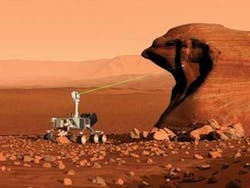MATERIALS ANALYSIS: Thales ChemCam will bring LIBS to Mars
After several years of intensive development activity, Thales Laser (Orsay, France) delivered the ChemCam Laser Flight Model to the Centre National d’Etudes Spatiales (CNES; Paris, France), the space agency for France. ChemCam is a Franco-American instrument designed to perform rock and mineral analysis on Mars using laser-induced breakdown spectroscopy (LIBS).
The ChemCam LIBS system was proposed in 2004 by the Centre d’Etudes Spatiales et de Rayonnement (CESR; Toulouse, France) and CNES from the French side and Los Alamos National Laboratories (LANL; Los Alamos, NM) from the American side in response to a National Aeronautics and Space Administration (NASA; www.nasa.gov) tender aimed at preparing the future Mars Science Laboratory (MSL09) mission. This mission is planned to occur between 2010 and 2011 after the space launch scheduled for late 2009.
While NASA is responsible for the development of rover it selected eight instruments (including ChemCam and its associated scientific program) among nearly 50 proposals from the international community. The ability of ChemCam to perform material analysis at some distance from the rover is expected to expand by a factor of 10 the global surface of Mars explored compared to earlier Mars missions (Spirit and Opportunity). The remote analysis capabilities will make it possible to investigate “difficult to access” areas of the red planet. The first LIBS instrument on a planet other than earth, ChemCam is intended to guide the mission with its ability to perform quasi real-time analysis, making it possible to choose the most interesting zones before completing investigations with other instruments.
The LIBS process creates a plasma through the interaction of the laser beam with the rocks to be analyzed, at a distance that will vary between 1 and 9 m from the rover. Atoms in the plasma rise to an excited state, jump back to their fundamental state, and generate radiation emissions specific to each atomic constituent of the rock. Analysis of these emissions is performed by a spectrometer located inside the rover after a short transit of the emission beam through a telescope and optical fibers.
The laser at the heart of ChemCam is an optimized version of Thales’ DIVA laser, but engineered over a two-year period with a factor of 15 to 20 size reduction (both weight and volume), twice the power output, and with stringent environmental resistance to radiation, dust, vibration, and shock—and operating from -30°C to +30°C without any thermal management. The result is a pulsed 1067 nm Q-switched diode-pumped solid-state laser that delivers 40 mJ per pulse with a pulse duration of less than 10 ns at a 10 Hz repetition rate, and weighing only 530 g in a 5 × 5 × 20 cm3 volume.
To achieve this performance without cooling, Thales Laser used an architecture based on an oscillator followed by two slab amplifiers. The oscillator—designed for high beam quality—is based on a crystal rod longitudinally pumped by a diode stack. The very wide spectral acceptance of the rod allows very small absorption variations over wide temperature ranges, allowing both the diode and the rod to be conductively cooled. The oscillator is Q-switched with a Pockels cell to produce the nanosecond pulses needed for LIBS.
“This program has been a great success, considering the technological challenge,” said Gérard Labaune, CEO of Thales Laser. “Lasers in space was a dream that will now become reality and we are proud to have taken a role in such an ambitious partnership.”
About the Author

Gail Overton
Senior Editor (2004-2020)
Gail has more than 30 years of engineering, marketing, product management, and editorial experience in the photonics and optical communications industry. Before joining the staff at Laser Focus World in 2004, she held many product management and product marketing roles in the fiber-optics industry, most notably at Hughes (El Segundo, CA), GTE Labs (Waltham, MA), Corning (Corning, NY), Photon Kinetics (Beaverton, OR), and Newport Corporation (Irvine, CA). During her marketing career, Gail published articles in WDM Solutions and Sensors magazine and traveled internationally to conduct product and sales training. Gail received her BS degree in physics, with an emphasis in optics, from San Diego State University in San Diego, CA in May 1986.
